Woolworths Brand Strategy: Brand Equity and Image Analysis
VerifiedAdded on 2023/04/03
|20
|4155
|175
Report
AI Summary
This report provides an in-depth analysis of Woolworths' brand strategy, focusing on key aspects such as brand image, brand equity, and the application of Keller's customer-based brand equity model. It explores how Woolworths manages its brand perception, builds brand awareness, and fosters brand loyalty. The report also discusses the functional and symbolic elements of the brand, highlighting Woolworths' efforts to create a positive brand image through its logo, green initiatives, and customer-centric strategies. Furthermore, it examines how the company leverages social media and data mining to enhance customer experience and maintain brand equity in the competitive Australian supermarket industry. Desklib is a great platform for students to find similar solved assignments and past papers.
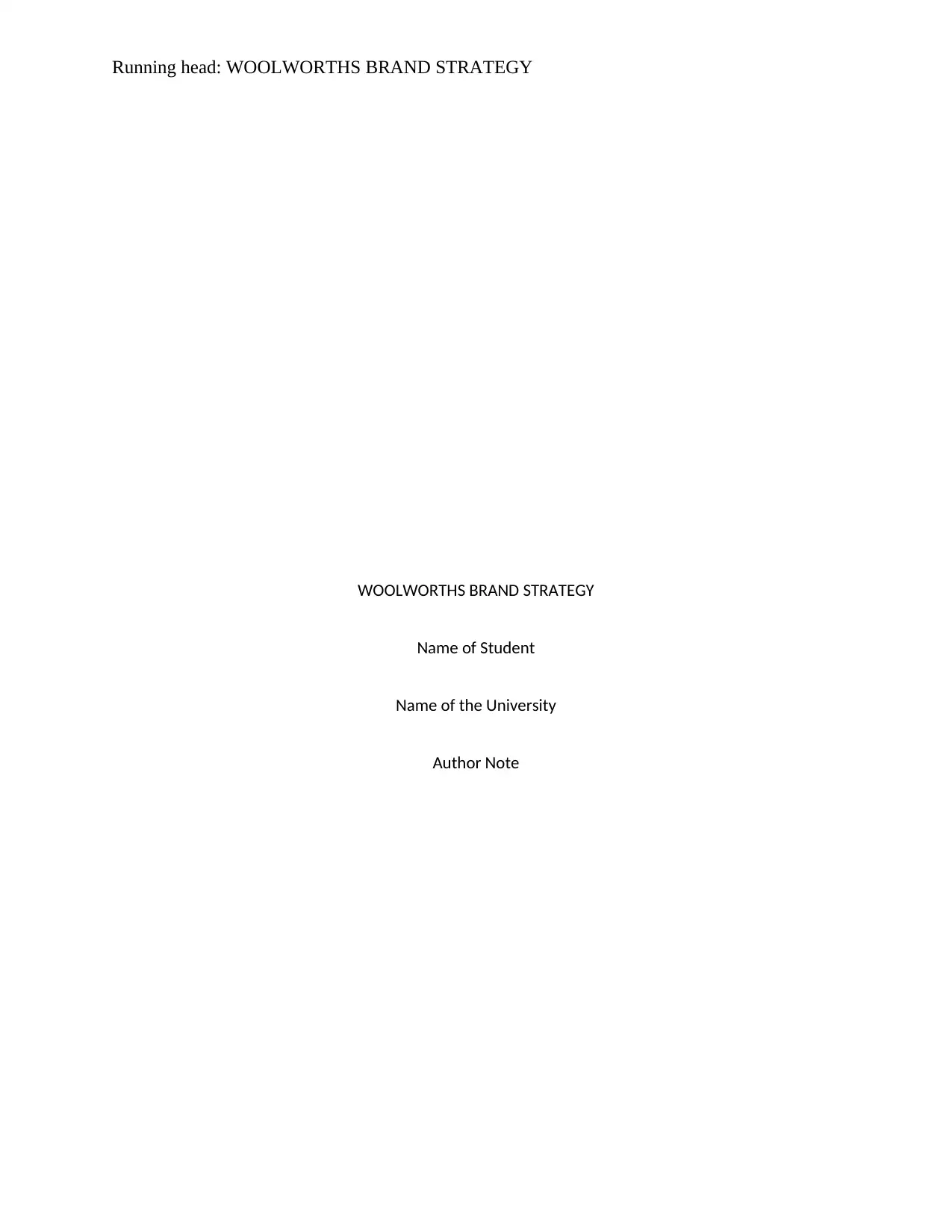
Running head: WOOLWORTHS BRAND STRATEGY
WOOLWORTHS BRAND STRATEGY
Name of Student
Name of the University
Author Note
WOOLWORTHS BRAND STRATEGY
Name of Student
Name of the University
Author Note
Paraphrase This Document
Need a fresh take? Get an instant paraphrase of this document with our AI Paraphraser
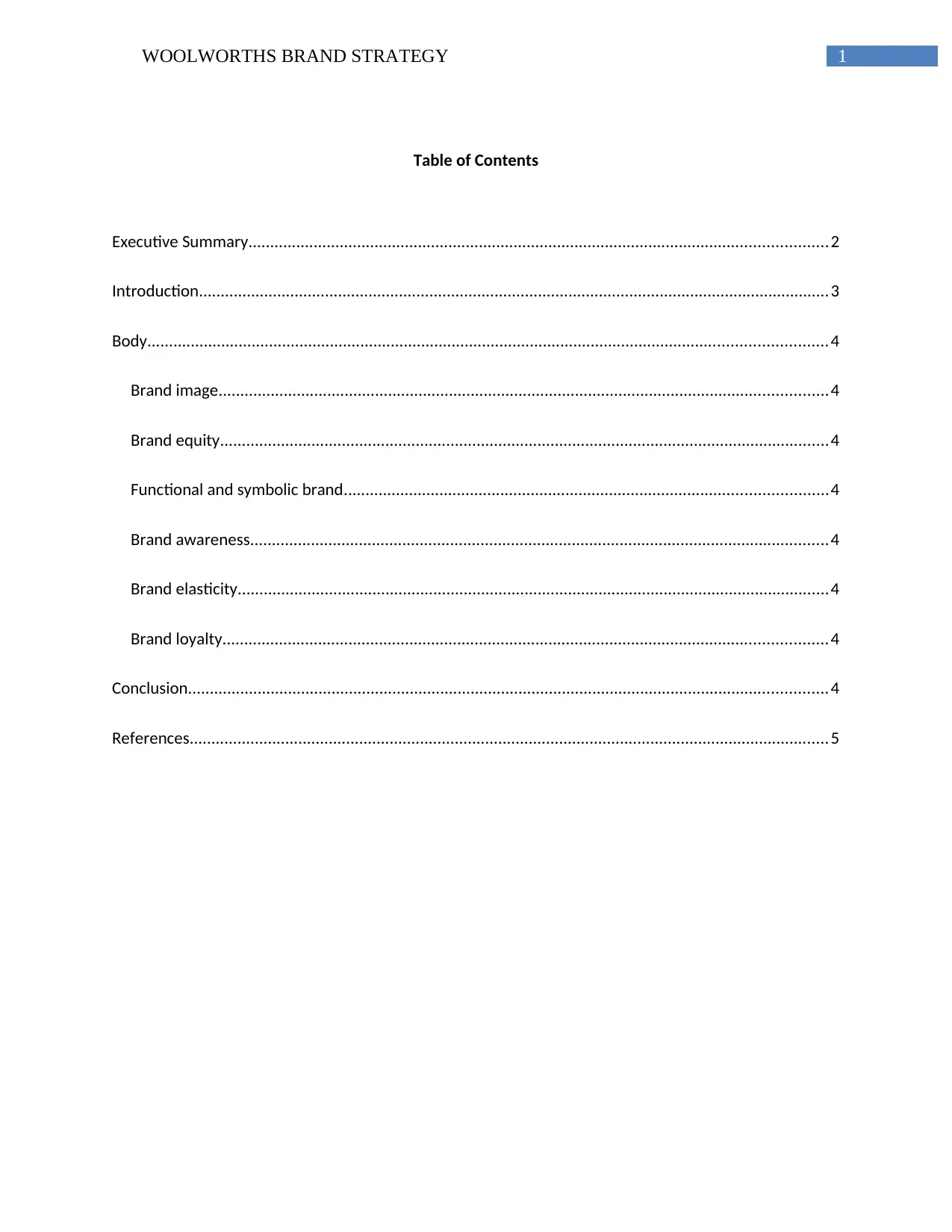
1WOOLWORTHS BRAND STRATEGY
Table of Contents
Executive Summary.....................................................................................................................................2
Introduction.................................................................................................................................................3
Body............................................................................................................................................................4
Brand image............................................................................................................................................4
Brand equity............................................................................................................................................4
Functional and symbolic brand...............................................................................................................4
Brand awareness.....................................................................................................................................4
Brand elasticity........................................................................................................................................4
Brand loyalty...........................................................................................................................................4
Conclusion...................................................................................................................................................4
References...................................................................................................................................................5
Table of Contents
Executive Summary.....................................................................................................................................2
Introduction.................................................................................................................................................3
Body............................................................................................................................................................4
Brand image............................................................................................................................................4
Brand equity............................................................................................................................................4
Functional and symbolic brand...............................................................................................................4
Brand awareness.....................................................................................................................................4
Brand elasticity........................................................................................................................................4
Brand loyalty...........................................................................................................................................4
Conclusion...................................................................................................................................................4
References...................................................................................................................................................5
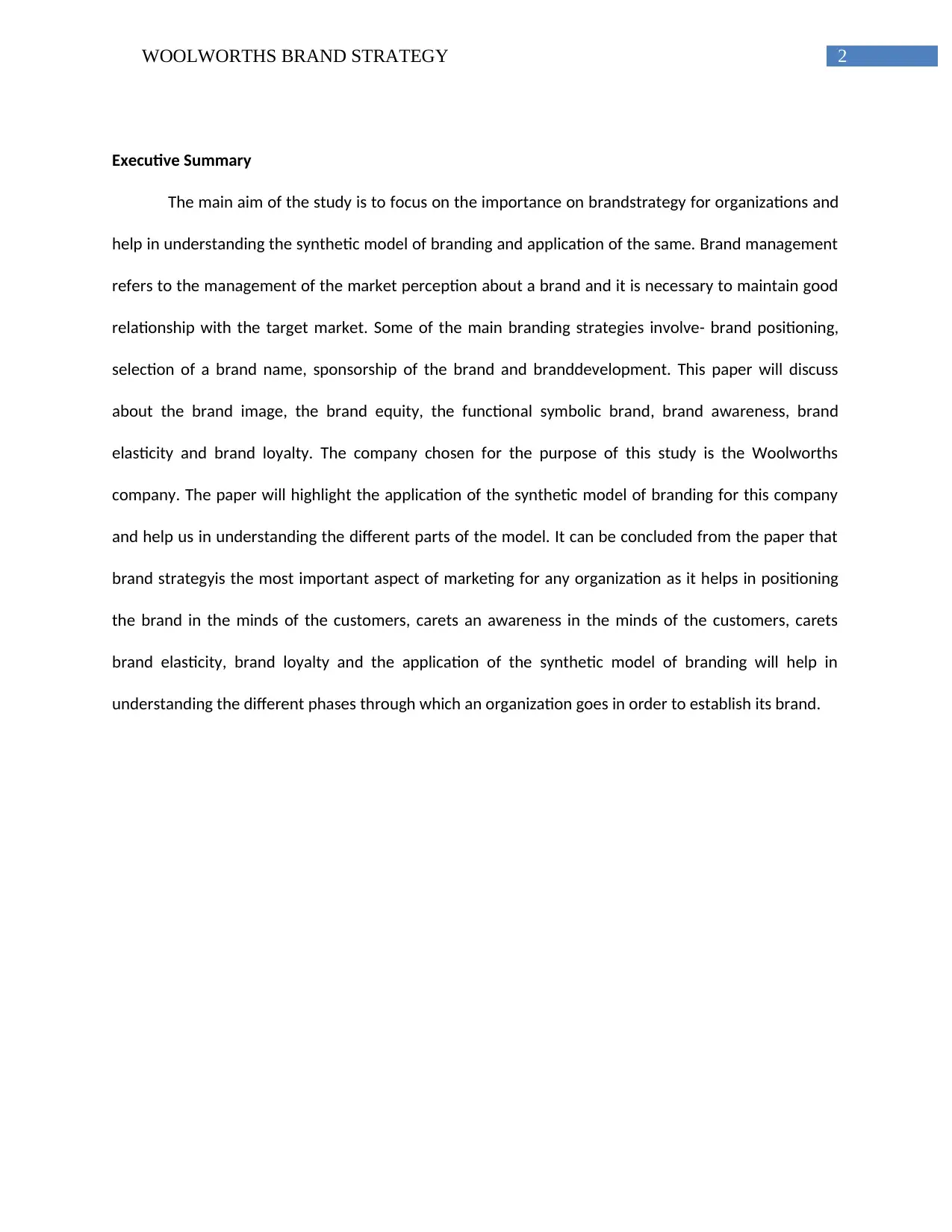
2WOOLWORTHS BRAND STRATEGY
Executive Summary
The main aim of the study is to focus on the importance on brandstrategy for organizations and
help in understanding the synthetic model of branding and application of the same. Brand management
refers to the management of the market perception about a brand and it is necessary to maintain good
relationship with the target market. Some of the main branding strategies involve- brand positioning,
selection of a brand name, sponsorship of the brand and branddevelopment. This paper will discuss
about the brand image, the brand equity, the functional symbolic brand, brand awareness, brand
elasticity and brand loyalty. The company chosen for the purpose of this study is the Woolworths
company. The paper will highlight the application of the synthetic model of branding for this company
and help us in understanding the different parts of the model. It can be concluded from the paper that
brand strategyis the most important aspect of marketing for any organization as it helps in positioning
the brand in the minds of the customers, carets an awareness in the minds of the customers, carets
brand elasticity, brand loyalty and the application of the synthetic model of branding will help in
understanding the different phases through which an organization goes in order to establish its brand.
Executive Summary
The main aim of the study is to focus on the importance on brandstrategy for organizations and
help in understanding the synthetic model of branding and application of the same. Brand management
refers to the management of the market perception about a brand and it is necessary to maintain good
relationship with the target market. Some of the main branding strategies involve- brand positioning,
selection of a brand name, sponsorship of the brand and branddevelopment. This paper will discuss
about the brand image, the brand equity, the functional symbolic brand, brand awareness, brand
elasticity and brand loyalty. The company chosen for the purpose of this study is the Woolworths
company. The paper will highlight the application of the synthetic model of branding for this company
and help us in understanding the different parts of the model. It can be concluded from the paper that
brand strategyis the most important aspect of marketing for any organization as it helps in positioning
the brand in the minds of the customers, carets an awareness in the minds of the customers, carets
brand elasticity, brand loyalty and the application of the synthetic model of branding will help in
understanding the different phases through which an organization goes in order to establish its brand.
⊘ This is a preview!⊘
Do you want full access?
Subscribe today to unlock all pages.

Trusted by 1+ million students worldwide
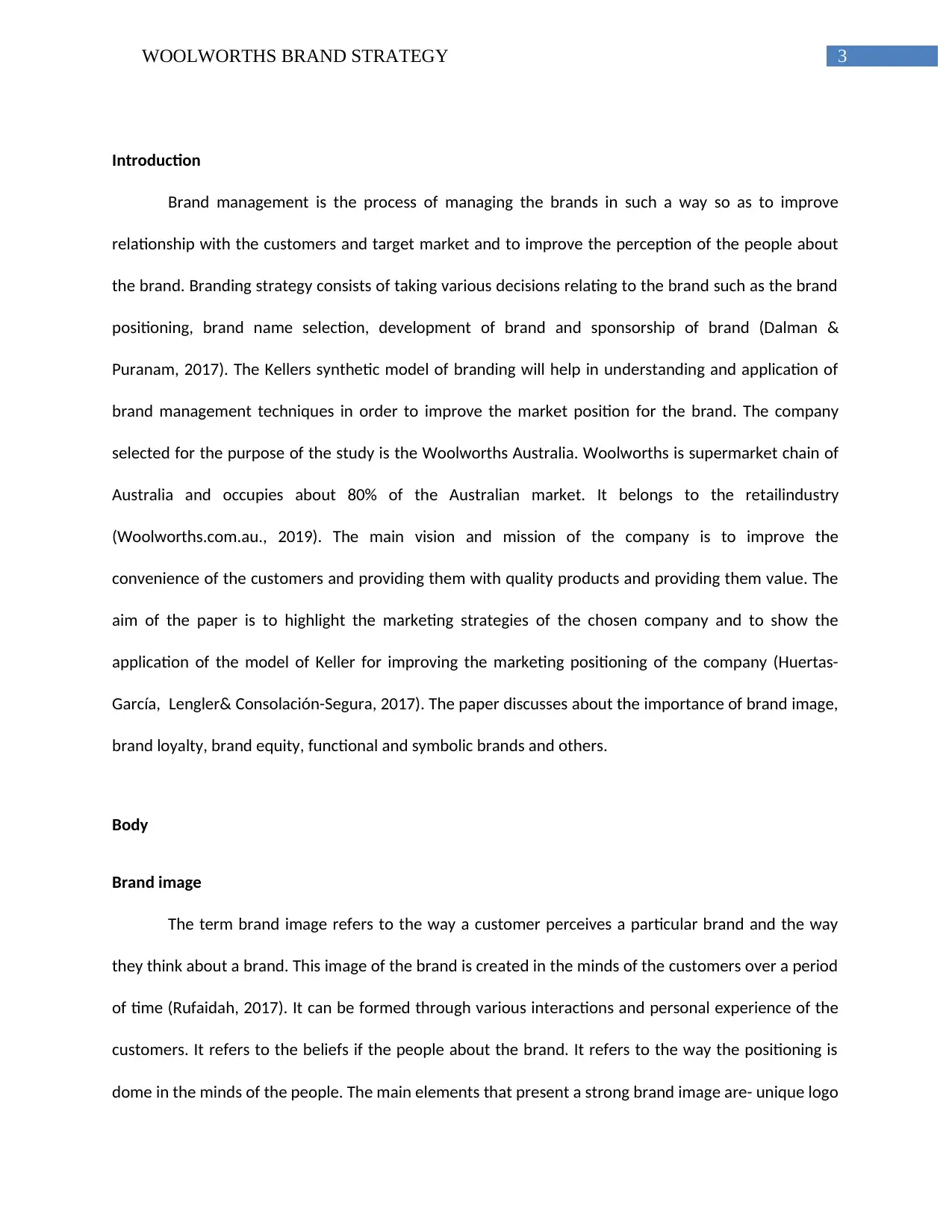
3WOOLWORTHS BRAND STRATEGY
Introduction
Brand management is the process of managing the brands in such a way so as to improve
relationship with the customers and target market and to improve the perception of the people about
the brand. Branding strategy consists of taking various decisions relating to the brand such as the brand
positioning, brand name selection, development of brand and sponsorship of brand (Dalman &
Puranam, 2017). The Kellers synthetic model of branding will help in understanding and application of
brand management techniques in order to improve the market position for the brand. The company
selected for the purpose of the study is the Woolworths Australia. Woolworths is supermarket chain of
Australia and occupies about 80% of the Australian market. It belongs to the retailindustry
(Woolworths.com.au., 2019). The main vision and mission of the company is to improve the
convenience of the customers and providing them with quality products and providing them value. The
aim of the paper is to highlight the marketing strategies of the chosen company and to show the
application of the model of Keller for improving the marketing positioning of the company (Huertas-
García, Lengler& Consolación-Segura, 2017). The paper discusses about the importance of brand image,
brand loyalty, brand equity, functional and symbolic brands and others.
Body
Brand image
The term brand image refers to the way a customer perceives a particular brand and the way
they think about a brand. This image of the brand is created in the minds of the customers over a period
of time (Rufaidah, 2017). It can be formed through various interactions and personal experience of the
customers. It refers to the beliefs if the people about the brand. It refers to the way the positioning is
dome in the minds of the people. The main elements that present a strong brand image are- unique logo
Introduction
Brand management is the process of managing the brands in such a way so as to improve
relationship with the customers and target market and to improve the perception of the people about
the brand. Branding strategy consists of taking various decisions relating to the brand such as the brand
positioning, brand name selection, development of brand and sponsorship of brand (Dalman &
Puranam, 2017). The Kellers synthetic model of branding will help in understanding and application of
brand management techniques in order to improve the market position for the brand. The company
selected for the purpose of the study is the Woolworths Australia. Woolworths is supermarket chain of
Australia and occupies about 80% of the Australian market. It belongs to the retailindustry
(Woolworths.com.au., 2019). The main vision and mission of the company is to improve the
convenience of the customers and providing them with quality products and providing them value. The
aim of the paper is to highlight the marketing strategies of the chosen company and to show the
application of the model of Keller for improving the marketing positioning of the company (Huertas-
García, Lengler& Consolación-Segura, 2017). The paper discusses about the importance of brand image,
brand loyalty, brand equity, functional and symbolic brands and others.
Body
Brand image
The term brand image refers to the way a customer perceives a particular brand and the way
they think about a brand. This image of the brand is created in the minds of the customers over a period
of time (Rufaidah, 2017). It can be formed through various interactions and personal experience of the
customers. It refers to the beliefs if the people about the brand. It refers to the way the positioning is
dome in the minds of the people. The main elements that present a strong brand image are- unique logo
Paraphrase This Document
Need a fresh take? Get an instant paraphrase of this document with our AI Paraphraser
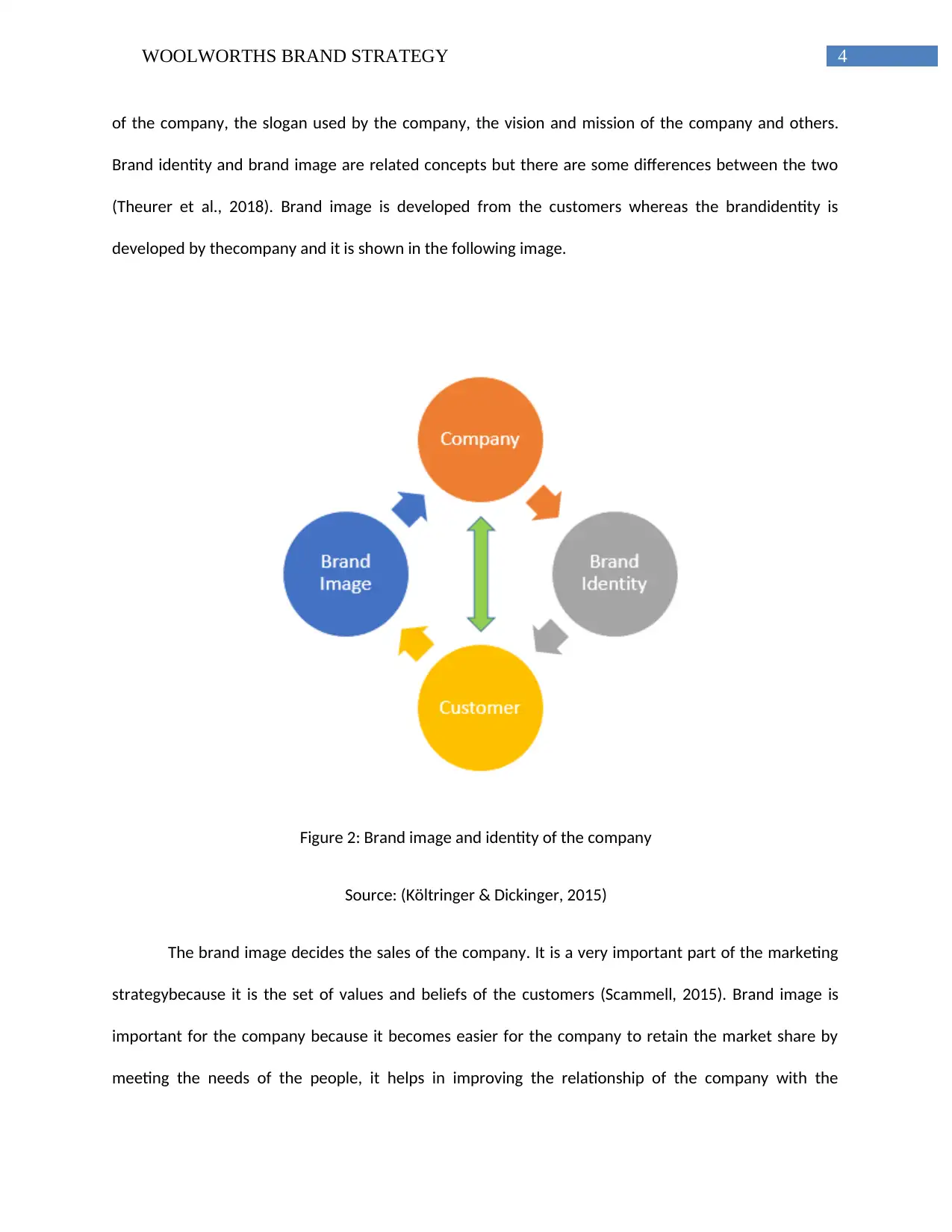
4WOOLWORTHS BRAND STRATEGY
of the company, the slogan used by the company, the vision and mission of the company and others.
Brand identity and brand image are related concepts but there are some differences between the two
(Theurer et al., 2018). Brand image is developed from the customers whereas the brandidentity is
developed by thecompany and it is shown in the following image.
Figure 2: Brand image and identity of the company
Source: (Költringer & Dickinger, 2015)
The brand image decides the sales of the company. It is a very important part of the marketing
strategybecause it is the set of values and beliefs of the customers (Scammell, 2015). Brand image is
important for the company because it becomes easier for the company to retain the market share by
meeting the needs of the people, it helps in improving the relationship of the company with the
of the company, the slogan used by the company, the vision and mission of the company and others.
Brand identity and brand image are related concepts but there are some differences between the two
(Theurer et al., 2018). Brand image is developed from the customers whereas the brandidentity is
developed by thecompany and it is shown in the following image.
Figure 2: Brand image and identity of the company
Source: (Költringer & Dickinger, 2015)
The brand image decides the sales of the company. It is a very important part of the marketing
strategybecause it is the set of values and beliefs of the customers (Scammell, 2015). Brand image is
important for the company because it becomes easier for the company to retain the market share by
meeting the needs of the people, it helps in improving the relationship of the company with the
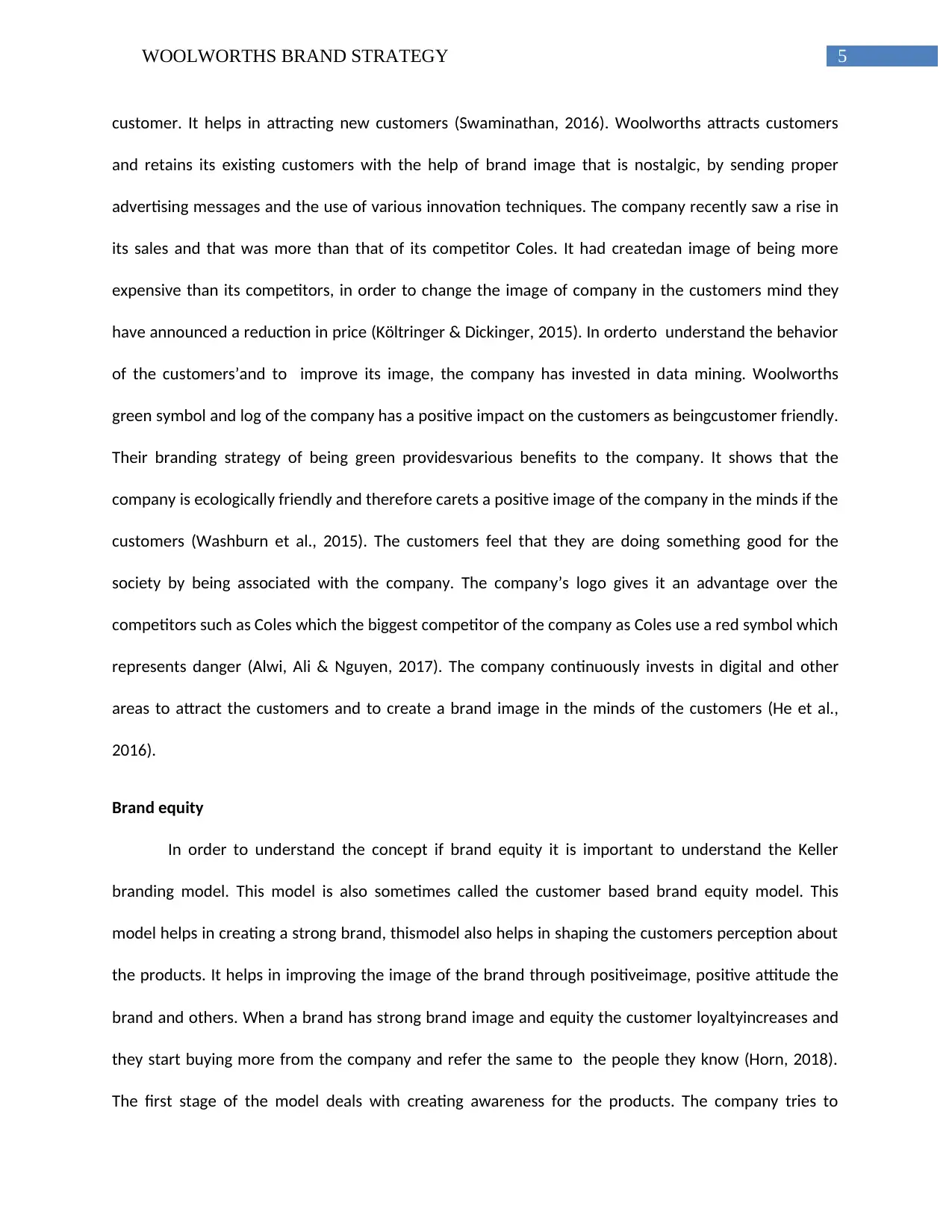
5WOOLWORTHS BRAND STRATEGY
customer. It helps in attracting new customers (Swaminathan, 2016). Woolworths attracts customers
and retains its existing customers with the help of brand image that is nostalgic, by sending proper
advertising messages and the use of various innovation techniques. The company recently saw a rise in
its sales and that was more than that of its competitor Coles. It had createdan image of being more
expensive than its competitors, in order to change the image of company in the customers mind they
have announced a reduction in price (Költringer & Dickinger, 2015). In orderto understand the behavior
of the customers’and to improve its image, the company has invested in data mining. Woolworths
green symbol and log of the company has a positive impact on the customers as beingcustomer friendly.
Their branding strategy of being green providesvarious benefits to the company. It shows that the
company is ecologically friendly and therefore carets a positive image of the company in the minds if the
customers (Washburn et al., 2015). The customers feel that they are doing something good for the
society by being associated with the company. The company’s logo gives it an advantage over the
competitors such as Coles which the biggest competitor of the company as Coles use a red symbol which
represents danger (Alwi, Ali & Nguyen, 2017). The company continuously invests in digital and other
areas to attract the customers and to create a brand image in the minds of the customers (He et al.,
2016).
Brand equity
In order to understand the concept if brand equity it is important to understand the Keller
branding model. This model is also sometimes called the customer based brand equity model. This
model helps in creating a strong brand, thismodel also helps in shaping the customers perception about
the products. It helps in improving the image of the brand through positiveimage, positive attitude the
brand and others. When a brand has strong brand image and equity the customer loyaltyincreases and
they start buying more from the company and refer the same to the people they know (Horn, 2018).
The first stage of the model deals with creating awareness for the products. The company tries to
customer. It helps in attracting new customers (Swaminathan, 2016). Woolworths attracts customers
and retains its existing customers with the help of brand image that is nostalgic, by sending proper
advertising messages and the use of various innovation techniques. The company recently saw a rise in
its sales and that was more than that of its competitor Coles. It had createdan image of being more
expensive than its competitors, in order to change the image of company in the customers mind they
have announced a reduction in price (Költringer & Dickinger, 2015). In orderto understand the behavior
of the customers’and to improve its image, the company has invested in data mining. Woolworths
green symbol and log of the company has a positive impact on the customers as beingcustomer friendly.
Their branding strategy of being green providesvarious benefits to the company. It shows that the
company is ecologically friendly and therefore carets a positive image of the company in the minds if the
customers (Washburn et al., 2015). The customers feel that they are doing something good for the
society by being associated with the company. The company’s logo gives it an advantage over the
competitors such as Coles which the biggest competitor of the company as Coles use a red symbol which
represents danger (Alwi, Ali & Nguyen, 2017). The company continuously invests in digital and other
areas to attract the customers and to create a brand image in the minds of the customers (He et al.,
2016).
Brand equity
In order to understand the concept if brand equity it is important to understand the Keller
branding model. This model is also sometimes called the customer based brand equity model. This
model helps in creating a strong brand, thismodel also helps in shaping the customers perception about
the products. It helps in improving the image of the brand through positiveimage, positive attitude the
brand and others. When a brand has strong brand image and equity the customer loyaltyincreases and
they start buying more from the company and refer the same to the people they know (Horn, 2018).
The first stage of the model deals with creating awareness for the products. The company tries to
⊘ This is a preview!⊘
Do you want full access?
Subscribe today to unlock all pages.

Trusted by 1+ million students worldwide
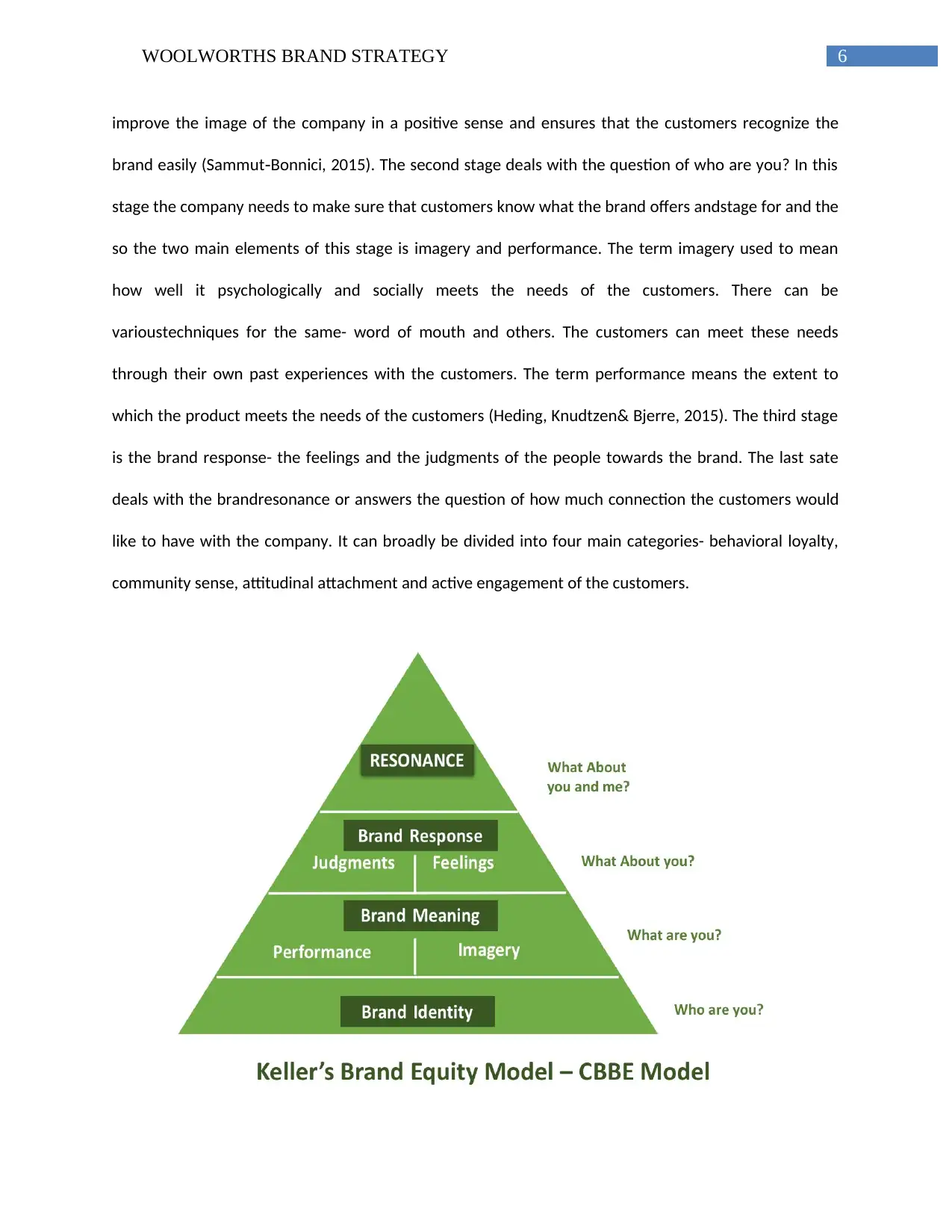
6WOOLWORTHS BRAND STRATEGY
improve the image of the company in a positive sense and ensures that the customers recognize the
brand easily (Sammut Bonnici, 2015). The second stage deals with the question of who are you? In this‐
stage the company needs to make sure that customers know what the brand offers andstage for and the
so the two main elements of this stage is imagery and performance. The term imagery used to mean
how well it psychologically and socially meets the needs of the customers. There can be
varioustechniques for the same- word of mouth and others. The customers can meet these needs
through their own past experiences with the customers. The term performance means the extent to
which the product meets the needs of the customers (Heding, Knudtzen& Bjerre, 2015). The third stage
is the brand response- the feelings and the judgments of the people towards the brand. The last sate
deals with the brandresonance or answers the question of how much connection the customers would
like to have with the company. It can broadly be divided into four main categories- behavioral loyalty,
community sense, attitudinal attachment and active engagement of the customers.
improve the image of the company in a positive sense and ensures that the customers recognize the
brand easily (Sammut Bonnici, 2015). The second stage deals with the question of who are you? In this‐
stage the company needs to make sure that customers know what the brand offers andstage for and the
so the two main elements of this stage is imagery and performance. The term imagery used to mean
how well it psychologically and socially meets the needs of the customers. There can be
varioustechniques for the same- word of mouth and others. The customers can meet these needs
through their own past experiences with the customers. The term performance means the extent to
which the product meets the needs of the customers (Heding, Knudtzen& Bjerre, 2015). The third stage
is the brand response- the feelings and the judgments of the people towards the brand. The last sate
deals with the brandresonance or answers the question of how much connection the customers would
like to have with the company. It can broadly be divided into four main categories- behavioral loyalty,
community sense, attitudinal attachment and active engagement of the customers.
Paraphrase This Document
Need a fresh take? Get an instant paraphrase of this document with our AI Paraphraser
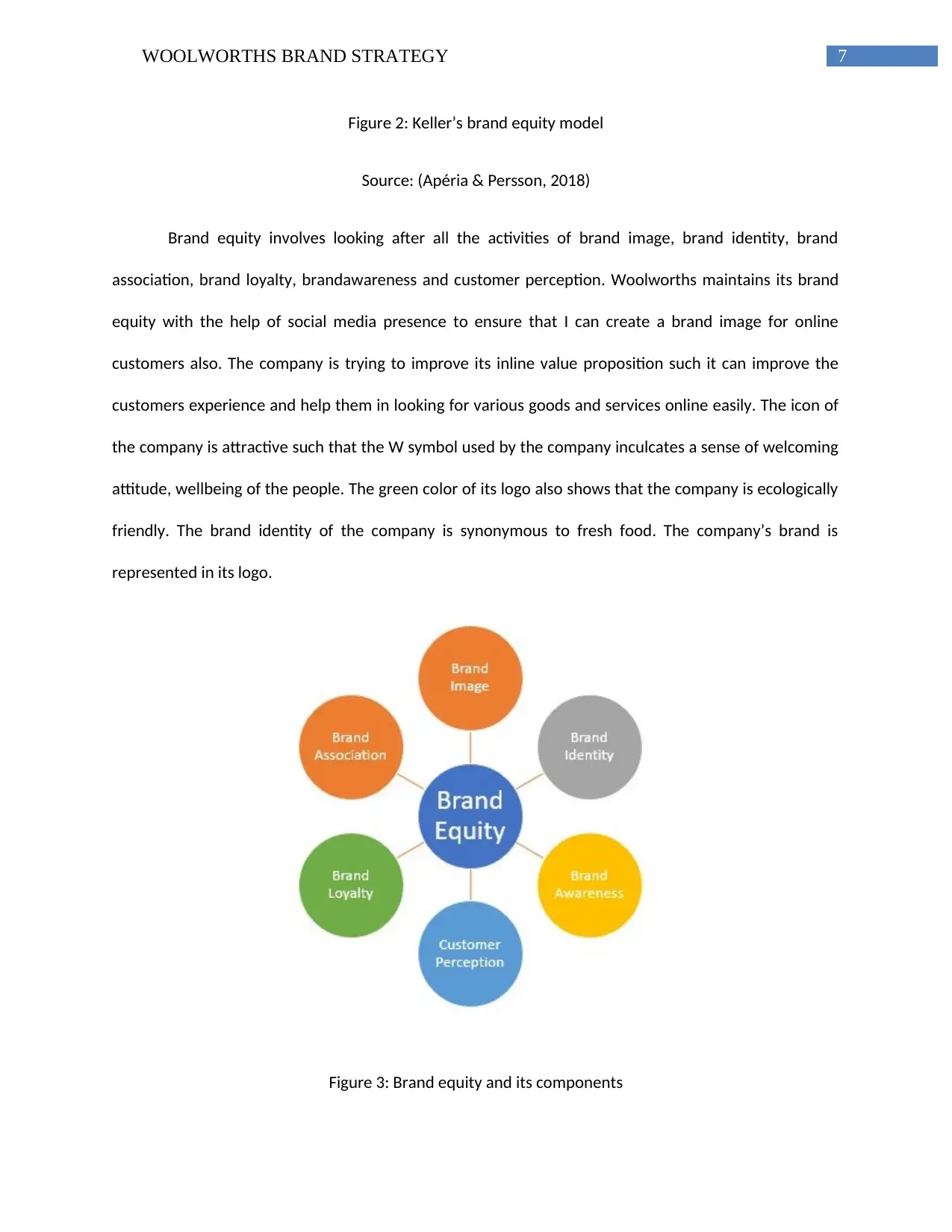
7WOOLWORTHS BRAND STRATEGY
Figure 2: Keller’s brand equity model
Source: (Apéria & Persson, 2018)
Brand equity involves looking after all the activities of brand image, brand identity, brand
association, brand loyalty, brandawareness and customer perception. Woolworths maintains its brand
equity with the help of social media presence to ensure that I can create a brand image for online
customers also. The company is trying to improve its inline value proposition such it can improve the
customers experience and help them in looking for various goods and services online easily. The icon of
the company is attractive such that the W symbol used by the company inculcates a sense of welcoming
attitude, wellbeing of the people. The green color of its logo also shows that the company is ecologically
friendly. The brand identity of the company is synonymous to fresh food. The company’s brand is
represented in its logo.
Figure 3: Brand equity and its components
Figure 2: Keller’s brand equity model
Source: (Apéria & Persson, 2018)
Brand equity involves looking after all the activities of brand image, brand identity, brand
association, brand loyalty, brandawareness and customer perception. Woolworths maintains its brand
equity with the help of social media presence to ensure that I can create a brand image for online
customers also. The company is trying to improve its inline value proposition such it can improve the
customers experience and help them in looking for various goods and services online easily. The icon of
the company is attractive such that the W symbol used by the company inculcates a sense of welcoming
attitude, wellbeing of the people. The green color of its logo also shows that the company is ecologically
friendly. The brand identity of the company is synonymous to fresh food. The company’s brand is
represented in its logo.
Figure 3: Brand equity and its components
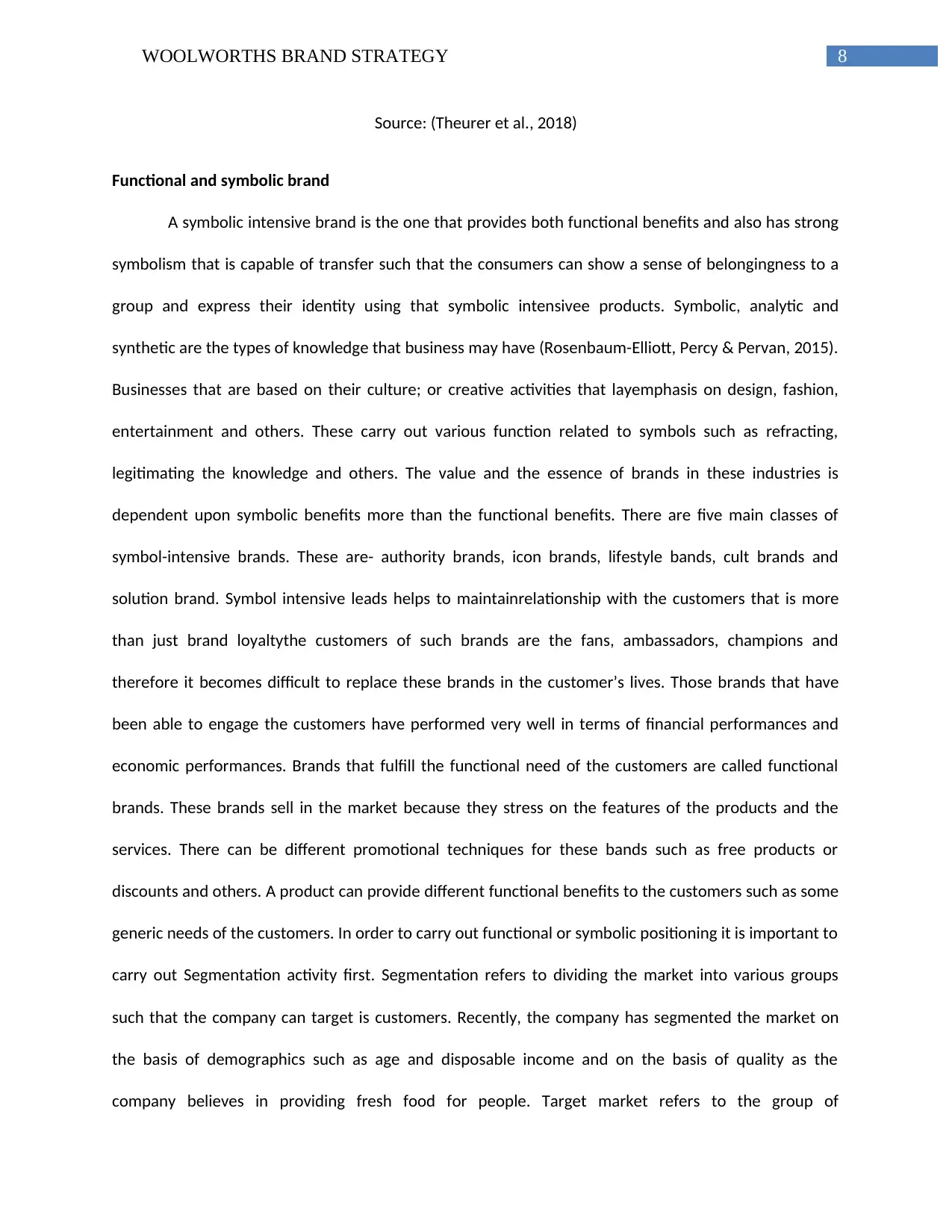
8WOOLWORTHS BRAND STRATEGY
Source: (Theurer et al., 2018)
Functional and symbolic brand
A symbolic intensive brand is the one that provides both functional benefits and also has strong
symbolism that is capable of transfer such that the consumers can show a sense of belongingness to a
group and express their identity using that symbolic intensivee products. Symbolic, analytic and
synthetic are the types of knowledge that business may have (Rosenbaum-Elliott, Percy & Pervan, 2015).
Businesses that are based on their culture; or creative activities that layemphasis on design, fashion,
entertainment and others. These carry out various function related to symbols such as refracting,
legitimating the knowledge and others. The value and the essence of brands in these industries is
dependent upon symbolic benefits more than the functional benefits. There are five main classes of
symbol-intensive brands. These are- authority brands, icon brands, lifestyle bands, cult brands and
solution brand. Symbol intensive leads helps to maintainrelationship with the customers that is more
than just brand loyaltythe customers of such brands are the fans, ambassadors, champions and
therefore it becomes difficult to replace these brands in the customer’s lives. Those brands that have
been able to engage the customers have performed very well in terms of financial performances and
economic performances. Brands that fulfill the functional need of the customers are called functional
brands. These brands sell in the market because they stress on the features of the products and the
services. There can be different promotional techniques for these bands such as free products or
discounts and others. A product can provide different functional benefits to the customers such as some
generic needs of the customers. In order to carry out functional or symbolic positioning it is important to
carry out Segmentation activity first. Segmentation refers to dividing the market into various groups
such that the company can target is customers. Recently, the company has segmented the market on
the basis of demographics such as age and disposable income and on the basis of quality as the
company believes in providing fresh food for people. Target market refers to the group of
Source: (Theurer et al., 2018)
Functional and symbolic brand
A symbolic intensive brand is the one that provides both functional benefits and also has strong
symbolism that is capable of transfer such that the consumers can show a sense of belongingness to a
group and express their identity using that symbolic intensivee products. Symbolic, analytic and
synthetic are the types of knowledge that business may have (Rosenbaum-Elliott, Percy & Pervan, 2015).
Businesses that are based on their culture; or creative activities that layemphasis on design, fashion,
entertainment and others. These carry out various function related to symbols such as refracting,
legitimating the knowledge and others. The value and the essence of brands in these industries is
dependent upon symbolic benefits more than the functional benefits. There are five main classes of
symbol-intensive brands. These are- authority brands, icon brands, lifestyle bands, cult brands and
solution brand. Symbol intensive leads helps to maintainrelationship with the customers that is more
than just brand loyaltythe customers of such brands are the fans, ambassadors, champions and
therefore it becomes difficult to replace these brands in the customer’s lives. Those brands that have
been able to engage the customers have performed very well in terms of financial performances and
economic performances. Brands that fulfill the functional need of the customers are called functional
brands. These brands sell in the market because they stress on the features of the products and the
services. There can be different promotional techniques for these bands such as free products or
discounts and others. A product can provide different functional benefits to the customers such as some
generic needs of the customers. In order to carry out functional or symbolic positioning it is important to
carry out Segmentation activity first. Segmentation refers to dividing the market into various groups
such that the company can target is customers. Recently, the company has segmented the market on
the basis of demographics such as age and disposable income and on the basis of quality as the
company believes in providing fresh food for people. Target market refers to the group of
⊘ This is a preview!⊘
Do you want full access?
Subscribe today to unlock all pages.

Trusted by 1+ million students worldwide
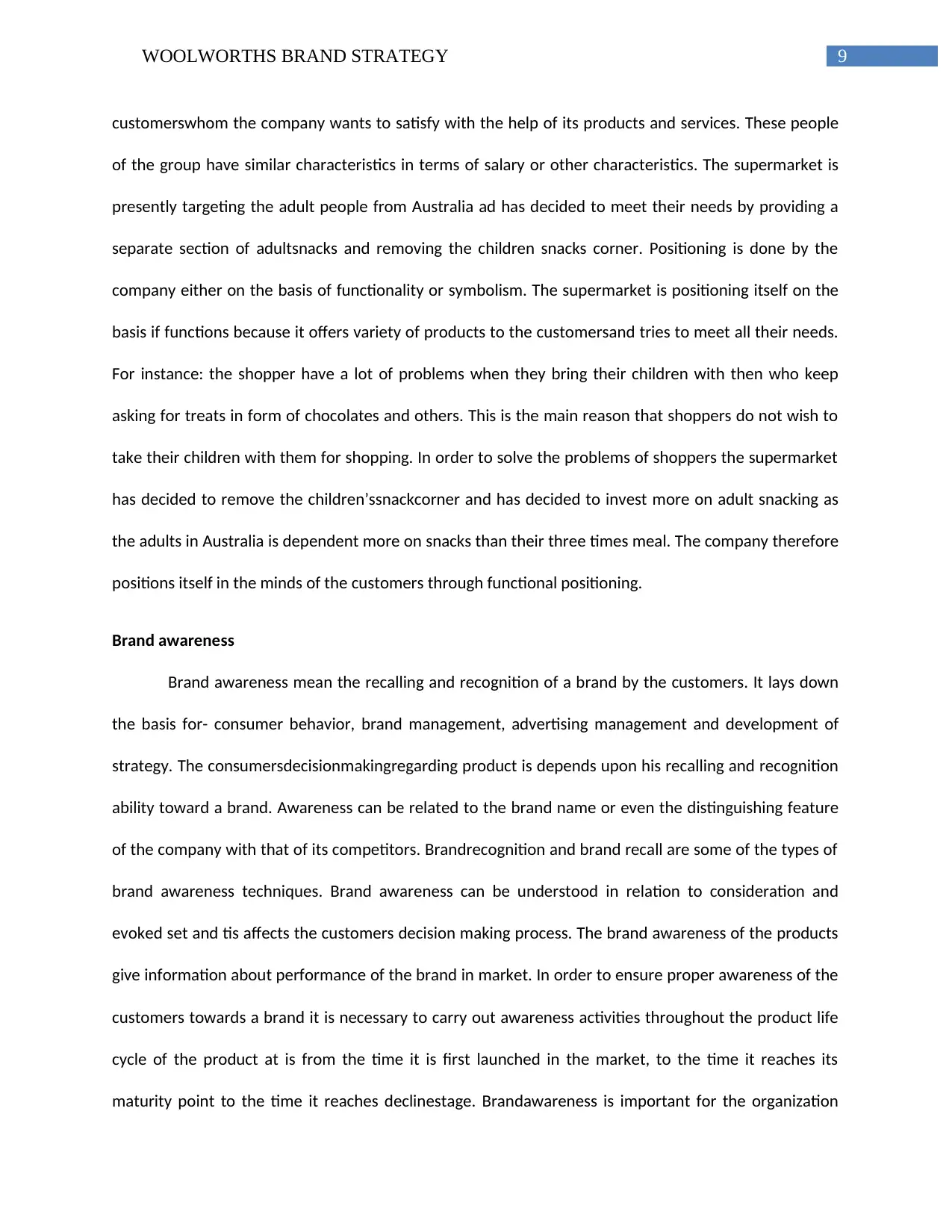
9WOOLWORTHS BRAND STRATEGY
customerswhom the company wants to satisfy with the help of its products and services. These people
of the group have similar characteristics in terms of salary or other characteristics. The supermarket is
presently targeting the adult people from Australia ad has decided to meet their needs by providing a
separate section of adultsnacks and removing the children snacks corner. Positioning is done by the
company either on the basis of functionality or symbolism. The supermarket is positioning itself on the
basis if functions because it offers variety of products to the customersand tries to meet all their needs.
For instance: the shopper have a lot of problems when they bring their children with then who keep
asking for treats in form of chocolates and others. This is the main reason that shoppers do not wish to
take their children with them for shopping. In order to solve the problems of shoppers the supermarket
has decided to remove the children’ssnackcorner and has decided to invest more on adult snacking as
the adults in Australia is dependent more on snacks than their three times meal. The company therefore
positions itself in the minds of the customers through functional positioning.
Brand awareness
Brand awareness mean the recalling and recognition of a brand by the customers. It lays down
the basis for- consumer behavior, brand management, advertising management and development of
strategy. The consumersdecisionmakingregarding product is depends upon his recalling and recognition
ability toward a brand. Awareness can be related to the brand name or even the distinguishing feature
of the company with that of its competitors. Brandrecognition and brand recall are some of the types of
brand awareness techniques. Brand awareness can be understood in relation to consideration and
evoked set and tis affects the customers decision making process. The brand awareness of the products
give information about performance of the brand in market. In order to ensure proper awareness of the
customers towards a brand it is necessary to carry out awareness activities throughout the product life
cycle of the product at is from the time it is first launched in the market, to the time it reaches its
maturity point to the time it reaches declinestage. Brandawareness is important for the organization
customerswhom the company wants to satisfy with the help of its products and services. These people
of the group have similar characteristics in terms of salary or other characteristics. The supermarket is
presently targeting the adult people from Australia ad has decided to meet their needs by providing a
separate section of adultsnacks and removing the children snacks corner. Positioning is done by the
company either on the basis of functionality or symbolism. The supermarket is positioning itself on the
basis if functions because it offers variety of products to the customersand tries to meet all their needs.
For instance: the shopper have a lot of problems when they bring their children with then who keep
asking for treats in form of chocolates and others. This is the main reason that shoppers do not wish to
take their children with them for shopping. In order to solve the problems of shoppers the supermarket
has decided to remove the children’ssnackcorner and has decided to invest more on adult snacking as
the adults in Australia is dependent more on snacks than their three times meal. The company therefore
positions itself in the minds of the customers through functional positioning.
Brand awareness
Brand awareness mean the recalling and recognition of a brand by the customers. It lays down
the basis for- consumer behavior, brand management, advertising management and development of
strategy. The consumersdecisionmakingregarding product is depends upon his recalling and recognition
ability toward a brand. Awareness can be related to the brand name or even the distinguishing feature
of the company with that of its competitors. Brandrecognition and brand recall are some of the types of
brand awareness techniques. Brand awareness can be understood in relation to consideration and
evoked set and tis affects the customers decision making process. The brand awareness of the products
give information about performance of the brand in market. In order to ensure proper awareness of the
customers towards a brand it is necessary to carry out awareness activities throughout the product life
cycle of the product at is from the time it is first launched in the market, to the time it reaches its
maturity point to the time it reaches declinestage. Brandawareness is important for the organization
Paraphrase This Document
Need a fresh take? Get an instant paraphrase of this document with our AI Paraphraser
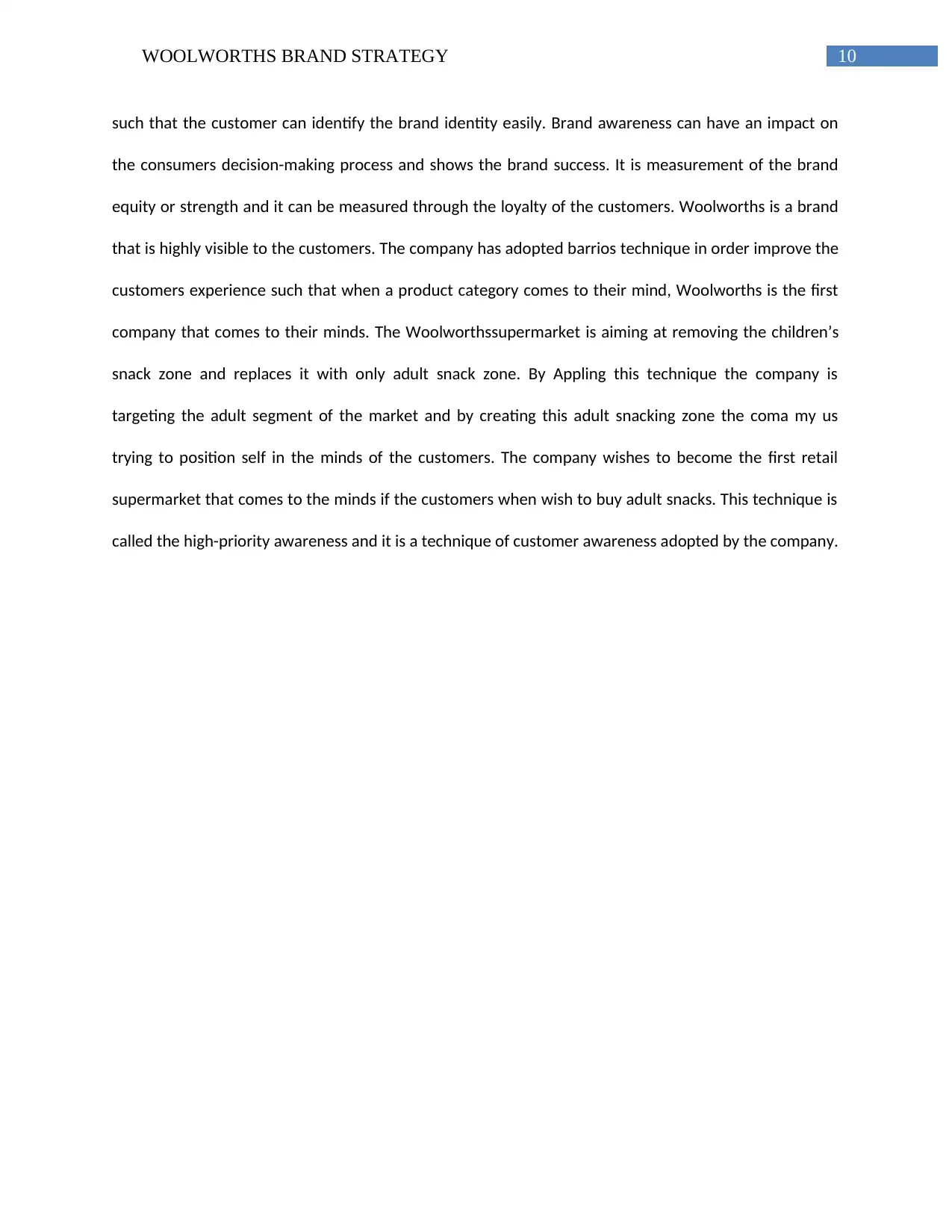
10WOOLWORTHS BRAND STRATEGY
such that the customer can identify the brand identity easily. Brand awareness can have an impact on
the consumers decision-making process and shows the brand success. It is measurement of the brand
equity or strength and it can be measured through the loyalty of the customers. Woolworths is a brand
that is highly visible to the customers. The company has adopted barrios technique in order improve the
customers experience such that when a product category comes to their mind, Woolworths is the first
company that comes to their minds. The Woolworthssupermarket is aiming at removing the children’s
snack zone and replaces it with only adult snack zone. By Appling this technique the company is
targeting the adult segment of the market and by creating this adult snacking zone the coma my us
trying to position self in the minds of the customers. The company wishes to become the first retail
supermarket that comes to the minds if the customers when wish to buy adult snacks. This technique is
called the high-priority awareness and it is a technique of customer awareness adopted by the company.
such that the customer can identify the brand identity easily. Brand awareness can have an impact on
the consumers decision-making process and shows the brand success. It is measurement of the brand
equity or strength and it can be measured through the loyalty of the customers. Woolworths is a brand
that is highly visible to the customers. The company has adopted barrios technique in order improve the
customers experience such that when a product category comes to their mind, Woolworths is the first
company that comes to their minds. The Woolworthssupermarket is aiming at removing the children’s
snack zone and replaces it with only adult snack zone. By Appling this technique the company is
targeting the adult segment of the market and by creating this adult snacking zone the coma my us
trying to position self in the minds of the customers. The company wishes to become the first retail
supermarket that comes to the minds if the customers when wish to buy adult snacks. This technique is
called the high-priority awareness and it is a technique of customer awareness adopted by the company.
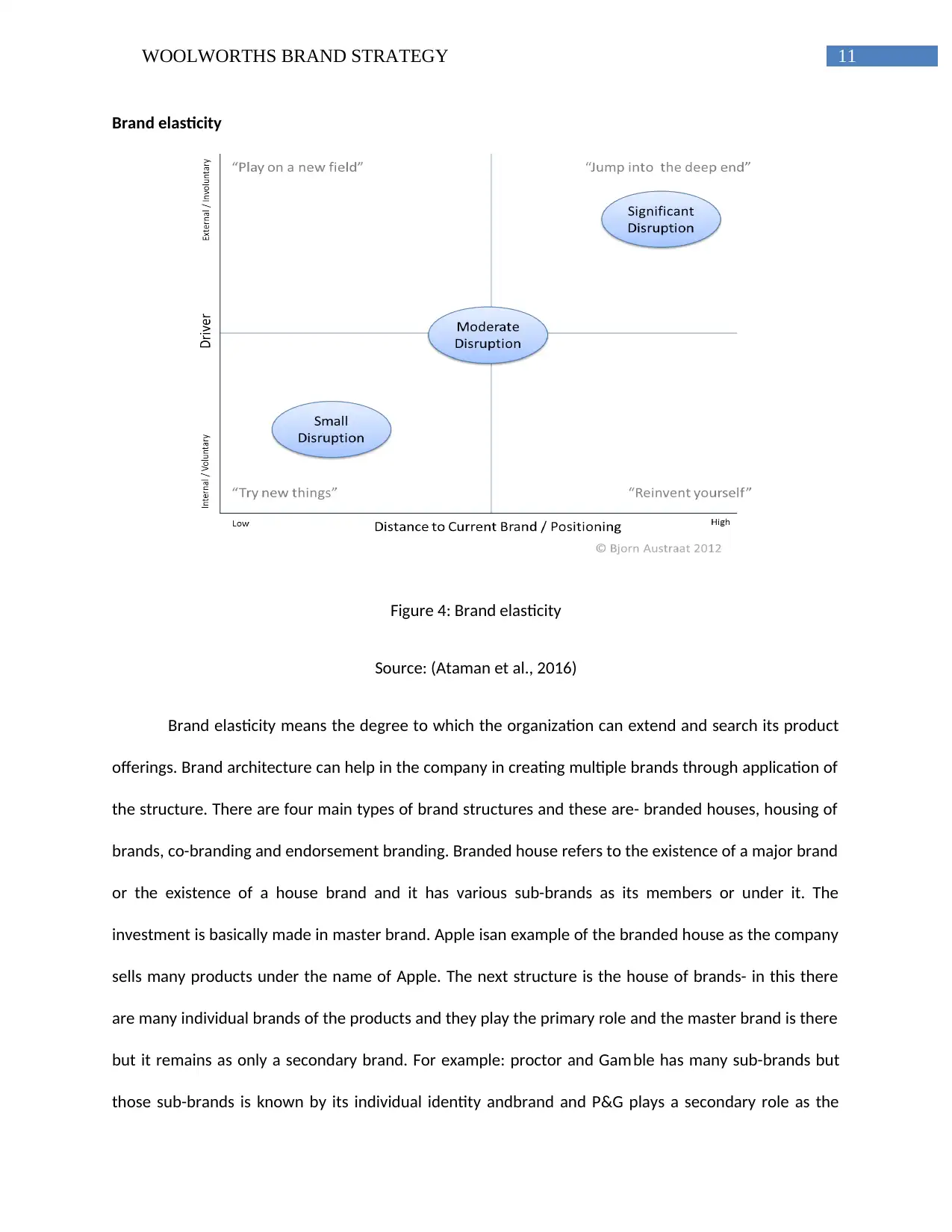
11WOOLWORTHS BRAND STRATEGY
Brand elasticity
Figure 4: Brand elasticity
Source: (Ataman et al., 2016)
Brand elasticity means the degree to which the organization can extend and search its product
offerings. Brand architecture can help in the company in creating multiple brands through application of
the structure. There are four main types of brand structures and these are- branded houses, housing of
brands, co-branding and endorsement branding. Branded house refers to the existence of a major brand
or the existence of a house brand and it has various sub-brands as its members or under it. The
investment is basically made in master brand. Apple isan example of the branded house as the company
sells many products under the name of Apple. The next structure is the house of brands- in this there
are many individual brands of the products and they play the primary role and the master brand is there
but it remains as only a secondary brand. For example: proctor and Gamble has many sub-brands but
those sub-brands is known by its individual identity andbrand and P&G plays a secondary role as the
Brand elasticity
Figure 4: Brand elasticity
Source: (Ataman et al., 2016)
Brand elasticity means the degree to which the organization can extend and search its product
offerings. Brand architecture can help in the company in creating multiple brands through application of
the structure. There are four main types of brand structures and these are- branded houses, housing of
brands, co-branding and endorsement branding. Branded house refers to the existence of a major brand
or the existence of a house brand and it has various sub-brands as its members or under it. The
investment is basically made in master brand. Apple isan example of the branded house as the company
sells many products under the name of Apple. The next structure is the house of brands- in this there
are many individual brands of the products and they play the primary role and the master brand is there
but it remains as only a secondary brand. For example: proctor and Gamble has many sub-brands but
those sub-brands is known by its individual identity andbrand and P&G plays a secondary role as the
⊘ This is a preview!⊘
Do you want full access?
Subscribe today to unlock all pages.

Trusted by 1+ million students worldwide
1 out of 20
Related Documents
Your All-in-One AI-Powered Toolkit for Academic Success.
+13062052269
info@desklib.com
Available 24*7 on WhatsApp / Email
![[object Object]](/_next/static/media/star-bottom.7253800d.svg)
Unlock your academic potential
Copyright © 2020–2025 A2Z Services. All Rights Reserved. Developed and managed by ZUCOL.




